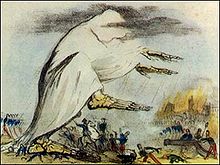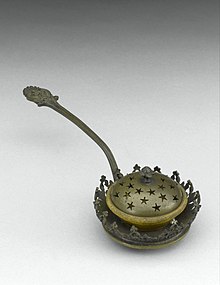Miasm


Miasma ( neuter ; from ancient Greek μίασμα miasma , German , defilement, pollution ' ) means something like "bad haze, pollution, defilement, contagion" and pointed particularly to a "disease-causing matter, which is caused by rotting processes in air and water." The scope of this term is not limited to the biological-medical effect of the "disease transmission" ( miasmatic infection ), but can also be applied in a figurative sense to the mental-emotional level.
Miasm in classical medicine
Hippocrates of Kos (around 460–375 BC) is considered to be the founder of the doctrine of miasms, the poisonous fumes of the soil that are carried away with the air (cf. “ Malaria ”) and thus contribute to the spread of diseases. In his work Über die Winde , he coined the term, which was later integrated into the concept of humoral pathology , as an epidemiological paradigm to explain the origin of the disease.
In the 19th century, due to a lack of knowledge about bacteria and viruses, doctors and researchers simply attributed epidemics such as cholera to bad smells that were spread via “miasms”. This theory later proved to be the wrong path of medicine, although the miasm model already partly explained where epidemics come from and how they spread.
The fear of miasms in many places led to quarantine-like conditions in many places as early as the Middle Ages. B. could spread the plague to the last corner of Europe. So the epidemic dead were buried outside the city and their belongings were burned. Cities isolated all strangers in quarantine during the plague , and the sick were permanently isolated from the rest of the healthy population. The plague doctors , also known as "beak doctors ", wore gloves, as well as beak-like masks equipped with herbs and liquids, which were supposed to protect against the "vapors" of the sick.
The weaknesses of the miasm model were recognized in London, although the makeshift rules for handling miasms such as cleanliness and isolation did in some cases limit epidemics.
In 1832, under the leadership of Edwin Chadwick , in response to the first cases of cholera, sewage and silt from the stinking London sewers were ordered to be flushed into the Thames . Since the companies that supplied London with drinking water took it from the Thames, the measure led to the contamination of the drinking water and a cholera epidemic with 14,000 deaths.
Joseph Griffiths Swayne (1819–1903), Frederick Brittan and William Budd (1811–1880) examined wastewater and found comma-shaped microorganisms. In 1849, John Snow and William Budd submitted a paper in which they believed that cholera was caused by living organisms in drinking water.
In 1854, John Snow and Arthur Hill Hassall submitted a new paper to the Medical Council of the General Board of Health in which they took the view that cholera was caused by living organisms in drinking water. You support Filippo Pacini (see below) to the effect that the agent of cholera must be a microorganism. They supported this hypothesis by comparing death rates in two London boroughs whose water was supplied by two different companies. In 1854, from the Soho cholera outbreak, Snow was able to demonstrate that water from a single public pump was responsible for almost all illnesses. The pump was closed, the outbreak was contained (see also: London sewer system ).
Despite this finding, the miasm theory was still widespread until around 1860. The discovery of the cholera bacterium in 1854 by the Italian Filippo Pacini was often ignored by medical experts until Robert Koch with Bernhard Fischer and Georg Gaffky convincingly demonstrated the connection between the bacterium and disease.
However, even under the paradigm of the miasm theory, without adopting bacteriology, an effective fight against cholera was already possible. The chemist and hygienist Max von Pettenkofer , who, assuming a "factor X" polluting the soil, had initiated an extensive rehabilitation of the Munich sewage system, was able to deal with the worldwide cholera epidemic of 1892 ( pandemic ) , which also reached Germany and more than 8,000 in Hamburg Fatality claimed, successfully preventing an outbreak of the disease in Munich - despite the crowds from abroad for the Oktoberfest.
Similarly, draining swamps in tropical zones seemed to remove the miasms responsible for malaria (from mal'aria , “bad air”) and yellow fever - in fact, the germ-carrying mosquitoes were deprived of the opportunity to breed.
See also
- Contagionists (adherents of the theory of contagion from person to person or from goods or objects, which is contrary to the miasmatic people)
literature
- Nikolaus Osterrieder et al .: Marek's disease virus: from miasma to model. In: Nature Reviews Microbiology , Vol. 4 (2006), pp. 283-294, ISSN 1740-1526 .
- Stephen Halliday: Death and miasma in Victorian London. An obstinate belief. In: British Medical Journal (BMJ), Vol. 323 (2001), pp. 1469-1471. PMID 11751359 , ISSN 0959-8154 .
- Valerie A. Curtis: Dirt, Disgust and Disease. A natural history of hygiene. In: Journal of epidemiology and community health , Vol. 61 (2007), pp. 660-644. PMID 17630362 , ISSN 0142-467X .
- Alain Corbin : breath of plague and scent of flowers. A history of smell ("Le Miasme et la Jonquille. L'odorat et l'imaginaire social XVIIIe-XIXe siècles", 1982). New edition Wagenbach, Berlin 2005, ISBN 3-8031-3517-6 .
Web links
Remarks
- ^ Wilhelm Pape , Max Sengebusch (arrangement): Concise dictionary of the Greek language . 3rd edition, 6th impression. Vieweg & Sohn, Braunschweig 1914 ( zeno.org [accessed on January 21, 2020]).
- ^ Wolfgang Wegner: Miasma. In: Werner E. Gerabek , Bernhard D. Haage, Gundolf Keil , Wolfgang Wegner (eds.): Enzyklopädie Medizingeschichte. De Gruyter, Berlin / New York 2005, ISBN 3-11-015714-4 , pp. 985 f .; here: p. 985.
- ^ Peter Payer : Indispensable props of the big city. A cultural history of Vienna's public lavatories . Löcker Verlag, Vienna 2000, ISBN 3-85409-323-3 , pp. 25 and 62 (also dissertation, University of Vienna 1999).
- ^ Wolfgang Wegner: Miasma. 2005, p. 985.
- ^ Wikisource Joseph Griffiths Swayne
- ^ Wikisource William Budd
- ↑ Swayne, JG and Budd, W., 'An account of certain organic cells in the peculiar evacuations of cholera', Lancet, 1849, 54: 398-399.
- ^ PE Brown: John Snow - the autumn loiterer. 519-528, online
- ↑ Milton Wainwright: Microbiology before Pasteur. Microbiology Today, Vol. 28 / Feb. 01, p. 20
- ^ Norman Howard-Jones: The scientific background of the International Sanitary Conferences. World Health Organization, Geneva 1975. In The second conference: Paris, 1859, p. 17, online
- ↑ Stephen Inwood: A History Of London. Macmillan, London 2000, ISBN 0-333-67154-6 , pp. 430-31.

